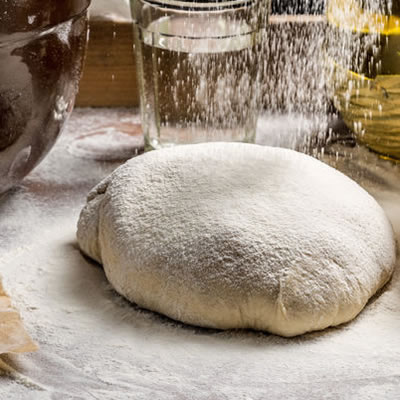Damaged starch absorbs up to 2–3 times more water than undamaged starch which only absorbs around 40% of its own weight.1,3
This form of starch has also greater susceptibility to degradation by amylolytic enzymes (both native and added) than undamaged granules yielding fermentable sugars (maltose and glucose) that support biochemical leavening.1,3
Application
Damaged starch is often an essential element of bread flour specifications. Some methods for measuring damaged starch include:1,4,5
- AACC International Official Method 76-31.01 (Cereals & Grains Association): It is based on damaged starch susceptibility to hydrolysis by amylases compared to native starch. The method employs a fungal α-amylase to hydrolyse and reduce the damaged starch to dextrins, followed by amyloglucosidase, which converts the dextrins to glucose, a reducing sugar. The glucose content is then determined by a spectrophotometric assay.
- Chopin SDmatic test: Is an automated amperometric method and is based on starch affinity to iodine. The higher the starch damage, the more iodine is bound and the smaller is the residual current.
- Near Infrared Reflectance (NIR) spectroscopy: Is an indirect method which compares light absorption of chemical groups in the IR spectrum.
Correlation between enzymatic and non-enzymatic methods is typically higher for flours from soft wheats than those from hard wheats.
Content of damaged starch as percent of total starch in flour:4
- Soft wheat: 1–4%
- Hard wheat (HRS and HRW): 6–12%
Relevant considerations for high-speed bakeries
As a rule of thumb, the harder the wheat, the higher the flour protein, so the higher the content of damaged starch. This is reflected in greater water absorption capacity and higher yeast activity ( fermentation rate).2
High starch damage can cause problems in high speed bread making operations that make use of dough systems with pre-ferments. Dough can become excessively sticky and gassy (too much food to ferment). The water that was absorbed and held by the damaged starch could be released into the dough once the polymer is broken down by enzymes (this increases use of dusting flour during makeup and makes dough handling more difficult).2
Damaged starch is very important in formulations low in added sugars and systems that make use of medium- to long-fermentation times such as poolish, sponge and dough and sourdough; all are made up of flour, water, baker’s yeast, wild yeast and air bacteria. In such cases, the damaged starch is key to support biochemical leavening that mellows the gluten in dough, produces unique flavors and aromas that improve the quality and texture of the finished product.
In order to make the most out of the damaged starch, bread flours should have enough diastatic (amylolytic) activity. A falling number of 250–300 sec is ideal. Any deficiencies in amylase activity should be supplemented with malted barley flour (diastatic) or by using a dough conditioners mix that contains amylases.
Damage of starch granules during milling is inevitable and natural although millers can have some control over its extent via:
- Adjusting roll pressure
- Selecting wheat hardness
- Using adequate wheat conditioning moisture levels
References
- Cauvain, S.P. “Raw Materials.” Baking Problems Solved, 2nd edition, Woodhead Publishing, Elsevier Ltd., 2017 pp. 59–60.
- Carson, G.R., and Edwards, N.M. “Criteria of Wheat and Flour quality.” Wheat Chemistry and Technology, 4th edition, AACC International, Inc., 2009, pp. 97–114.
- Miskelly, D., and Suter, D. “Assessing and Managing Wheat-Flour Quality Before, During and After Milling.” Cereal Grains: Assessing and Managing Quality, 2nd edition, Woodhead Publishing, Elsevier Ltd., 2017 pp. 618–619.
- Finnie, S., and Atwell, W.A. “Wheat and Flour Testing.” Wheat Flour, 2nd edition, AACC International, Inc., 2016, pp. 75–76.
- Serna-Saldivar, S.O. “Determination of Chemical and Nutritional Properties of Cereal Grains and Their Products.” Cereal Grains: Laboratory Reference and Procedures Manual, CRC Press, Taylor & Francis Group, LLC, 2012, p. 61.

